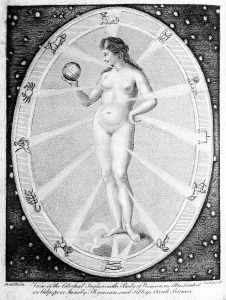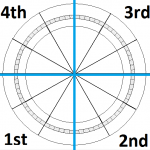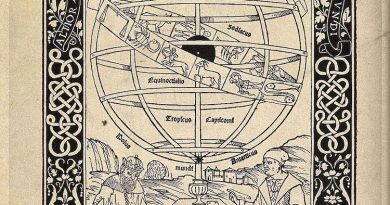Planets Rising in the Genethliacal Chart & the Native’s Body, Appearance and Traits [According to Ptolemy]
last updated: 17/May/2021
Note: For references, I utilized the version of the cosmopolitan Tetrabiblos from Ptolemy’s four books of the influence of the stars [or the Quadripartite Mathematical Treatise] translated from the Greek paraphrase of Proclus by j. m. Ashmand – more specifically I will refer this article to the Book III; chapter 11 and page 80-82 [London, Davis and Dickson; 1822].
–
“Per Topic” – Considerations
Sometimes I simple don’t understand the logic behind some astrological ancient and mysterious texts order’s per topic, it’s very curious. In this case for example, the subject of the title above (Planets Rising in the Genethliacal Chart & the Native’s Body, Appearance and Traits) is usually the ” first” thing we read in modern books. In Tetrabiblos, Egyptian Ptolemy puts the topic which is quite basic and easy to grasp in a single read, at the end of Book III soon after he discussed and taught the “Length of Life” in astrology, which is complicated enough to say the least. In the last book, he then disclosures among other essential universal topics, the quality of death and then ends the Quadripartite by introducing the “Ages of the Man”. Or another example is in Abú Ma’shar’s Great Introduction to the Judgment of the Stars, where he first lectures about the Share of the Planets [exaltations, detriments, joys etc.] and only later in Chapter VI he begins to discuss the Zodiac Signs and their classifications. I guess cultural priorities were others [?].
Of Bodily Form and Temperament

He begins the Chapter (11. Of Bodily Form and Temperament) from book III by writing the below [the bracelets are mine observations]:
“Now that the procedure in the matter of the length of life has been explained [expiration of the body], we Break about the form and character of the body [Ascendant + the Moon generally], beginning the detailed discussion in the proper order, inasmuch as naturally, too, the bodily parts are formed prior to the soul [Latin: Anima – the “animating principle”]; for the body, because it is more material, carries almost from birth the outward appearances of its idiosyncrasies [mannerism/traits], while the soul shows forth the characters conferred upon it by the first cause only afterwards and little by little, and external accidental qualities [external and out of our control conditions/situations] come about still later in time.”
Ptolemy then continues before explaining the effects of the Planets rising on the native’s radix [again, the bracelets observations are mine obviously]:
“We must, then, in general observe the eastern horizon and the planets that are upon it (…); and in particular also the moon as well; for it is through the formative power of these two places [the planet rising (if any) + Ascendant and the Moon] and of their rulers [around the chart somewhere] and through the mixture of the two kinds, and furthermore through the forms of the fixed stars [constellations; Zodiac signs] that are rising at the same time, that the conformation of the body is ascertained [determined?]; the ruling planets have most power in this matter and the special characters of their places aid them [for example, the nativity has Jupiter in another quadrant than the 1st and is retrograde, then that is another signification all together and visiable by appearance].”
An interesting detail is that, among the organization of the papyrus scrolls, the scientist and employer at the great Alexandria’s Library Ptolemy cared to discuss was when a planet is setting on the radix [7th house – Dsc], their motion status, rulers in quadrants – and how those could come about in form as well once the house impacts directly (but opposite) the endpoint of its axis [1st house – Asc], if the planet had rise before or after the Sun, indicating double kind of interpretation [Oriental or Occidental]. Curiously and crosswise to contemporary teachings, Ptolemy begins with the last planet visible to us by naked eye, the last traditional of the 7 astrological planets [the bold words and the bracelets are mine observations]:
Planet | Body and Temperament by Ptolemy |
Saturn | “… if he is in the orient, makes his subjects in appearance dark-skinned, robust, black-haired, curly-haired, hairy-chested, with eyes of moderate size, of middling stature, and in temperament having an excess of the moist and cold [wet and melancholic]. If Saturn is setting [in the 7th House], in appearance he makes them dark [of mysterious nature], slender, small, straight-haired, with little hair on the body, rather graceful, and black-eyed; in temperament, sharing most in the cold and dry [melancholic and choleric].” |
Jupiter | “…as the ruler of the aforesaid regions, when he is rising, makes his subjects in appearance light of skin, but in such a way as to have a good colour [texture and glow?], with moderately curling hair and large eyes, tall, and commanding respect; in temperament they exceed in the hot and the moist [heat and wet]. When Jupiter is setting, he makes his subjects light [skinny], to be sure, but not as befare, in such a way as to give them a good colour and with lank hair or even bald in front and on the crown, and of average stature; in temperament they have an excess of the moist [wet]. |
Mars | “Similarly, Mars, when rising, makes his subjects in appearance red and white of complexion, tall and robust, gray-eyed, with thick hair, somewhat curly, and in temperament showing an excess of the warm [hot] and dry [heat that originates from dry]. When he is setting, he makes them in appearance simply ruddy, of middle height, with small eyes, not much hair on the body, and straight yellow hair; their temperament exceeds in the dry.” |
Venus | “… has effects similar to Jupiter’s, but is apt to make her subjects more shapely, graceful, womanish, effeminate in figure, plump, and luxurious. On her own proper account she makes the eyes bright as well as beautiful.” [Heat and Wetness] |
Mercury | “…in the orient, makes his subjects in appearance sallow, of moderate height, graceful, with small eyes and moderately curling hair; in temperament, showing an excess of the warm [Abù Ma’shar says Cold instead]. In the occident he makes them, in appearance, of light but not of good coloring, with straight hair and olive complexion, lean and spare, with glancing, brilliant eyes, and somewhat ruddy; in temperament they exceed in the dry [Intellective Virtue]. |
Sun | “The luminaries assist each of these when they bear an aspect to them, the sun tending to a more impressive and robust effect…” [Attractiveness – Heat/Warm and Dry] |
Moon | “… especially when she is separating from the planets, in general tending toward better proportion and greater slenderness, and toward a more moist [Wet] temperament [Animal Virtue]; but in particular cases her effect is proportioned to the special quality of her illumination [the phases of the Moon], in accordance with the system of intermixture explained in the beginning of the treatise.” |
 Mathematician Ptolemy then continues with the following comments [I think here he then speaks about the planet’s motion in more detail]:
Mathematician Ptolemy then continues with the following comments [I think here he then speaks about the planet’s motion in more detail]:
“Again, generally, when the planets are morning stars and make an appearance, they make the body large; at their first station [before moving retrograde?], powerful and muscular; when they are moving forward [direct motion?] not well-proportioned; at their second station [retrograde?], rather weak; and at setting [7th place – Dsc], entirely without repute but able to bear hardship and oppression.”
Apparently, Ptolemy just explainned what may happen to the native’s body formation when the ruler of the Asc or the Moon, or the planet rising is having its motion back and forth on the genethliacal chart [between 1st and last retrograde motion to direct status]. The author then continues by discussing the ruler of the Ascendant and the Moon in the 4 quarters of the Zodiac wheel [nonetheless another planet may be rising in the radix]:
 “Likewise their places, as we have said, take an important part in the formation of the bodily characters and temperaments. In general terms, once more, the quadrant from the spring equinox to the summer solstice [Aries to 30° degrees Gemini] makes the subjects well-favored in complexion, stature, robustness, and eyes, and exceeding in the moist and warm. The quadrant from the summer solstice to the autumn equinox [Cancer to 30° degrees Virgo] produces individuals with moderately good complexion and moderate height, robust, with large eyes and thick and curly hair, exceeding in the warm and dry. The quadrant from the autumn equinox to the winter solstice [Libra to 30° degrees Sagittarius] makes them sallow, spare, slender, sickly, with moderately curling hair and good eyes, exceeding in the dry and cold. The quadrant from the winter solstice to the spring equinox [Capricorn to 30° degrees Pisces] produces individuals of dark complexion, moderate height, straight hair, with little hair on their bodies, somewhat graceful, and exceeding in the cold and moist.”
“Likewise their places, as we have said, take an important part in the formation of the bodily characters and temperaments. In general terms, once more, the quadrant from the spring equinox to the summer solstice [Aries to 30° degrees Gemini] makes the subjects well-favored in complexion, stature, robustness, and eyes, and exceeding in the moist and warm. The quadrant from the summer solstice to the autumn equinox [Cancer to 30° degrees Virgo] produces individuals with moderately good complexion and moderate height, robust, with large eyes and thick and curly hair, exceeding in the warm and dry. The quadrant from the autumn equinox to the winter solstice [Libra to 30° degrees Sagittarius] makes them sallow, spare, slender, sickly, with moderately curling hair and good eyes, exceeding in the dry and cold. The quadrant from the winter solstice to the spring equinox [Capricorn to 30° degrees Pisces] produces individuals of dark complexion, moderate height, straight hair, with little hair on their bodies, somewhat graceful, and exceeding in the cold and moist.”
By last, Ptolemy finishes the eleven chapter by discussing the prognostics for general constellations [Zodiac Signs] and the effects on body in terms of shape, size, potency and even beauty [gracefulness]:
Zodiac Signs | Body & Form |
Gemini – Virgo – Libra – First Half of Sagittarius – Aquarius | bodies which are harmonious of movement and well-proportioned |
The rest of the Zodiac Signs | modify the bodily proportions to correspond to their own peculiarities, and after a fashion make the corresponding parts like their own, larger and smaller, or stronger and weaker, or more and less graceful |
Contellations and their general sizes in body & form [in more detail] and even about unevenness:
Zodiac Signs | Body & Form |
Leo – Virgo – Sagittarius | larger |
Pisces – Cancer – Capricorn | Smaller |
Aries – Taurus – Leo | the upper and fore parts make them more robust and the lower and hind parts weaker |
Sagittarius – Scorpio – Gemini | Conversely the fore parts of these signs, cause slenderness and the hind parts robustness |
Virgo – Libra – Sagittarius | tend to make them well proportioned and graceful |
Scorpio – Pisces – Taurus [?] | bring about awkwardness and disproportion |
“… and it is fitting that we should observe and combine all these things and make a conjecture as to the character which results from the mixture [Zodiac sign rising + ruler of the Asc in a sign + Aspects to Sun or Moon perhaps more specifically], with regard both to the form and to the temperament of the body.”
Conclusion
From the Roman empire and Egyptian Ptolemy contributed much to the Tropical Zodiacal System, preparing generations ahead for a fixed wheel format to “play the game” instead of a sidereal system. His books pictured well the conditions of his time concerning the scientific field and astrology before the medieval era came around. Tetrabiblos does feel like a defense on astrology and is one of the quickest and practical book on astrology that won’t take your time for granted – because of its “cut to the chase” approach, beginners may find it quite hard to understand it, the book is well resumed and quite synthesized to maximum for such a long subject.
Now, concerning the Book III and specifically the Chapter 11, we found out that Ptolemy synthesized the result of body, form and temperament of the nativity while planets rise, rulers are around the chart somewhere in a quadrant, planets oriental or occidental, etc. In order, we could say Ptolemy wants us to look for this sequence:
1. Planets Rising on the Eastern Horizon + Moon Phase & Place
2. Ruler of the Asc position + Moon [Position Ruler; for example let her be in Aries, Mars is then the ruler]
3. What Zodiac Sign rises [Ascendant] + Moon Sign
Once identified each, the astrologer shall follow with the following condition: If the Planets are between First Station Retrograde to the last phase to Direct Motion Station.
I guess from this part we could say astrology can be quite deterministic sometimes rather than just denotative .
– –
References
Tetrabiblos Ptolemy’s four books of the influence of the stars [or the Quadripartite Mathematical Treatise] translated from the Greek paraphrase of Proclus by j. m. Ashmand – [London, Davis and Dickson; 1822]
Abù-Ma’shar – “The Great Introduction” translated by Benjamin N. Dykes, PhD [2020 – pages 246]
Virtues and temperaments by [PDF format]; Transcribed and annotated by Deborah Houlding – www.skyscript.co.uk/2 astrodiscourse.html

